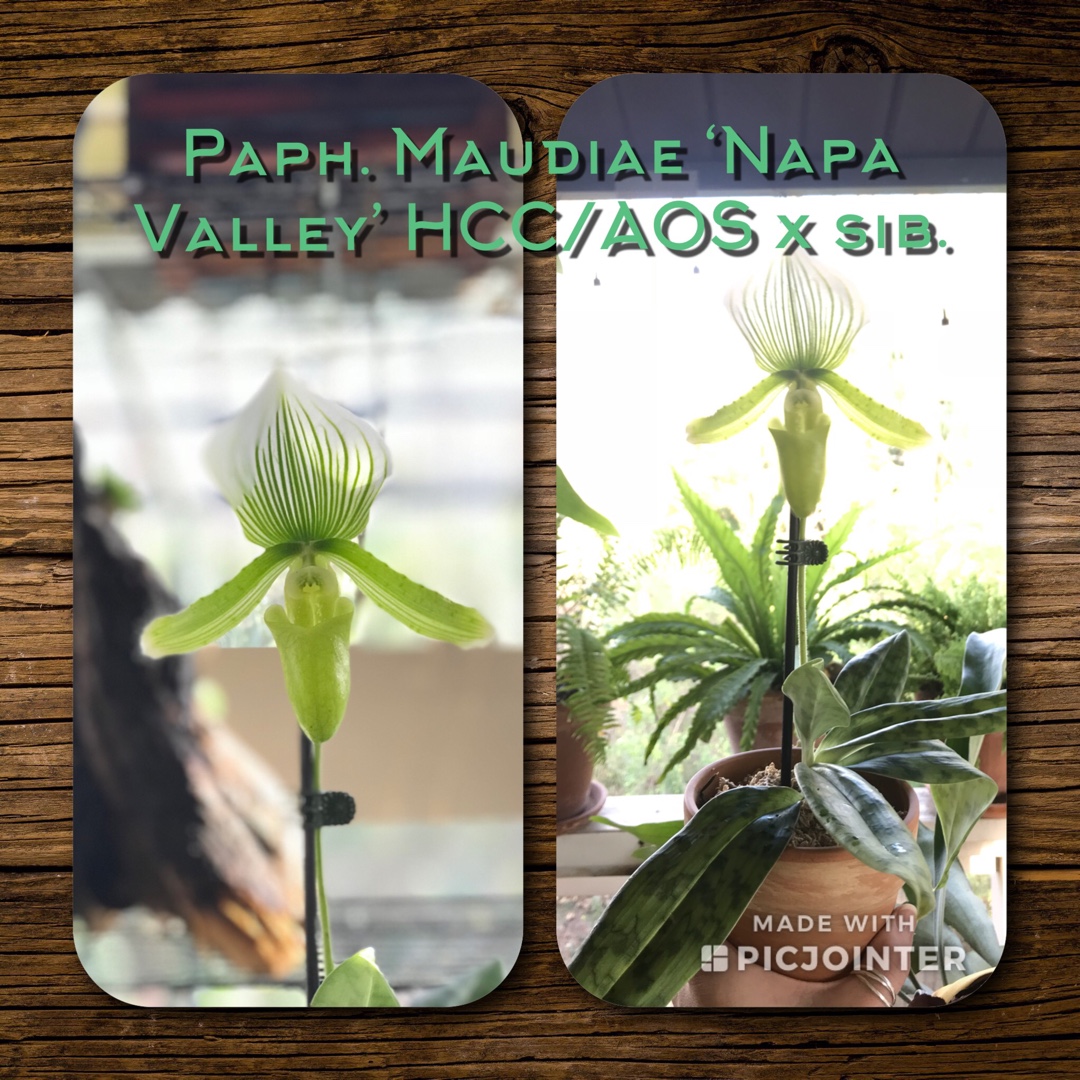
Paphiopedilum Maudiae 'Napa Valley' HCC AOS x Sic
Slipper Orchid 'Napa Valley'
Slipper orchids are mostly terrestrial orchids (i.e. they grow in the ground), but unlike many other terrestrial orchids, they do not produce pseudobulbs at the base of their stems. They are relatively easy to grow, as long as they have moderate to high humidity (50-70%), and temperatures ranging from 10-25°C (50-77°F) with a minimum winter temperature of 10-13°C (50-55°F). The mottled-leaved varieties need a warmer temperature - a minimum night temperature of 18°C (65°F) and a daytime temperature of 20-30°C (68-86°F) with high humidity. Slipper orchids need bright, indirect light. They can bloom at any time of the year, but generally flower from mid to late Autumn through to early Spring, with the flowers lasting up to 3 months. The common name "Slipper Orchid" comes from the flower's lip being slipper-shaped :'Napa Valley' Parents: Paphiopedilum callosum X Paphiopedilum lawrenceanum. The flowers are lime green and white, and delicately marked with fine stripes on the upper part, with a solid lime green pouch
Contributed by @jlsardina
-
Partial shade
-
Occasional watering
-
Not Frost hardy
-
Moist and free draining
Common name
Slipper Orchid 'Napa Valley'
Latin name
Paphiopedilum Maudiae 'Napa Valley' HCC AOS x Sic
type
Flowering plant
family
Orchidaceae
ph
5.0 - 7.5 Acid - Neutral
Plant & bloom calendar
-
Best time to plant
-
When the plant will bloom
full grown dimensions
 0.30 M
0.30 M
0.30 M
0.30 M
Paphiopedilum Maudiae 'Napa Valley' HCC AOS x Sic
Slipper orchids are mostly terrestrial orchids (i.e. they grow in the ground), but unlike many other terrestrial orchids, they do not produce pseudobulbs at the base of their stems. They are relatively easy to grow, as long as they have moderate to high humidity (50-70%), and temperatures ranging from 10-25°C (50-77°F) with a minimum winter temperature of 10-13°C (50-55°F). The mottled-leaved varieties need a warmer temperature - a minimum night temperature of 18°C (65°F) and a daytime temperature of 20-30°C (68-86°F) with high humidity. Slipper orchids need bright, indirect light. They can bloom at any time of the year, but generally flower from mid to late Autumn through to early Spring, with the flowers lasting up to 3 months. The common name "Slipper Orchid" comes from the flower's lip being slipper-shaped :'Napa Valley' Parents: Paphiopedilum callosum X Paphiopedilum lawrenceanum. The flowers are lime green and white, and delicately marked with fine stripes on the upper part, with a solid lime green pouch
Flowering
From Late Winter TO Early Spring
Slipper orchids generally flower from late winter to early Spring, but flowers can appear at any time of the year. Flowers last up to three months, and may need support with a stake.
Planting young plants
From Early Spring TO Late Winter
They prefer warm to cool temperatures and a growing medium of terrestrial orchid mix. Ensure good light levels in winter, as these are essential to encourage flowering. An east- or west-facing window would be ideal. Move to a shadier spot in summer and protect from direct sunshine.








